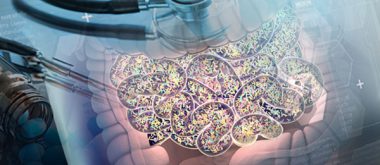Bladder cancer is the tenth most common cancer worldwide. The median age of onset is 71.9 years for men and 73.4 years for women. The disease is often associated with exposure to harmful chemicals such as those found in tobacco smoke. A new study shows that the bacteria in our gut may play an important role in the development of bladder cancer. The scientists were able to show experimentally that certain intestinal bacteria can convert a class of carcinogens, which are often found in cigarette smoke, into related chemicals that accumulate in the bladder and lead to tumors.
How Intestinal Bacteria and Bladder Cancer are Linked
At any one time, over 10 trillion microbes call our gut home. From breaking down the nutrients in our food to bolstering our immune defenses against pathogens, these microbes play an essential role in the way we interact with the world. This includes – as a new study by EMBL researchers and collaborators from the University of Split, Croatia, shows – the way the body responds to carcinogens and develops cancer. Carcinogens are chemicals that can cause normal cells to turn into cancer cells, leading to tumors and cancer. They are found in various places, with tobacco smoke being one of the most well-known sources. Researchers have already discovered that mice exposed to the nitrosamine BBN, one of the chemicals found in tobacco smoke, reliably develop an aggressive form of bladder cancer. This is therefore used as a standard laboratory model for carcinogen-induced cancer.
Janoš Terzi?’s laboratory at the University of Split in Croatia was studying this model when they made a curious observation. When the mice were given antibiotics at a dose that killed 99.9% of their gut bacteria and were exposed to BBN at the same time, they were much less likely to develop tumors. While 90% of all mice exposed to BBN developed bladder tumors, only 10% of the mice that were additionally given antibiotics developed tumors. This led her to hypothesize that the intestinal bacteria might be involved in regulating the way BBN is processed in the body. The decrease in tumor incidence was dramatic.
During a conference at EMBL Heidelberg, Terzi? met Michael Zimmermann, a group leader at EMBL Heidelberg. The Zimmermann group specializes in applying high-throughput techniques to study the functions of the gut microbiome, focusing mainly on a process called biotransformation. Biotransformation is the ability of microorganisms to alter or break down chemicals in their environment. From the first meeting, a fruitful collaboration emerged. The two groups decided to combine their expertise to understand whether and how gut bacteria influence the mice’s response to the carcinogen. Using a variety of microbiological and molecular biological methods, the researchers discovered that bacteria living in the mice’s gut can convert BBN to BCPN. Like BBN, BCPN belongs to a class of compounds called nitrosamines. However, the team found that, unlike BBN, BCPN concentrates in the urinary bladder and triggers tumor formation in a microbiome-dependent manner.
Next, the researchers screened over 500 isolated and cultured bacteria to identify the specific bacterial species involved in converting BBN to BCPN. They found 12 species that can carry out this carcinogenic biotransformation. The researchers sequenced them and were surprised to find that many of these species are skin-associated and only relatively few are found in the gut. They speculated that there might be a transient transfer of such bacteria from the skin to the gut as a result of the animals grooming each other. However, it was important to find out whether these results would also apply to humans.
Microorganisms and Their Interactions With Each Other
After these initial studies in mice, the scientists used human stool samples to show that human gut bacteria can also convert BBN to BCPN. As a proof of concept, they showed that they could also convert BBN to BCPN when human stool was transplanted into the gut of a mouse that did not have its own gut microbiome. However, the researchers also observed large individual differences in the ability of the human gut microbiome to metabolize BBN, as well as in the bacterial species involved in the biotransformation. “We believe this provides the basis for further research to see if an individual’s gut microbiome is a predisposing factor for chemical-induced carcinogenesis and could thus be used to predict individual risk and possibly prevent carcinogenesis,” said Zimmermann. According to Terzi?, these differences in the inter-individual microbiota could explain why some people do not develop cancer despite being exposed to potential carcinogens, while others do.
Does this mean that antibiotics can universally prevent cancer? Zimmermann says no, and explains that further studies are needed, including some she is currently conducting, to understand how the microbiome affects the metabolism of different types of carcinogens. It is also important to remember that cancer is a multifactorial disease – there is rarely a single cause. The study is in line with EMBL’s cross-cutting themes of Microbial Ecosystems and Human Ecosystems, introduced in its 2022-2026 program, Molecules to Ecosystems. The Microbial Ecosystems theme aims to explore microorganisms and their interactions with each other and their environment, while the Human Ecosystems theme plans to use the rapidly expanding human datasets to explore the interaction between genes and the environment and their impact on human phenotypes.






